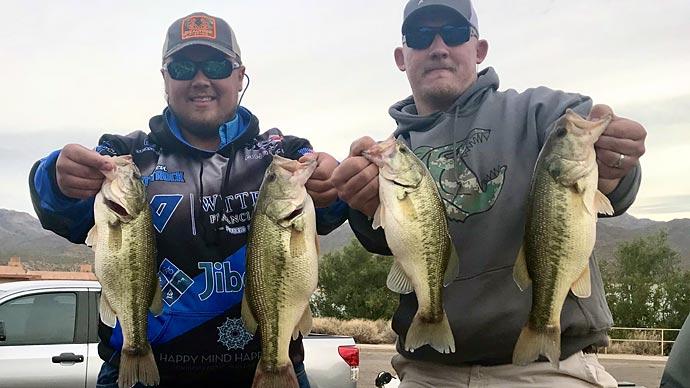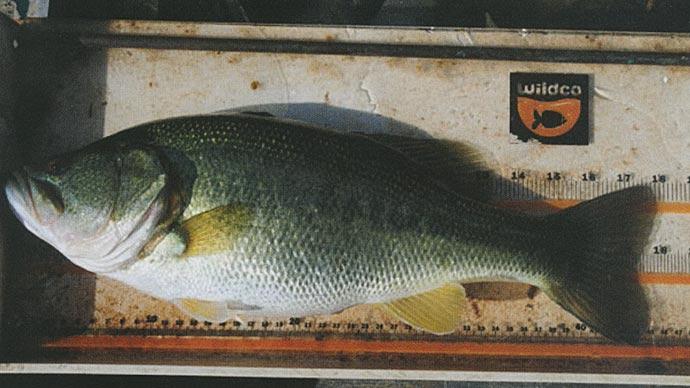Have you ever caught a bass in your pond you swear has been caught before? There's that telltale hook mark in the lip. and some special marking you have seen in the not too distant past.
Are largemouth bass "smart?" Well, that probably depends on who you talk to and what they are doing. So, we won't try to unload that loaded question. However, we do believe that largemouth bass can learn from past experiences.
In this article, we discuss two inter-related topics. First, we discuss how angler catches can be used to monitor largemouth bass populations in ponds. Then, we'll get into effects angling has on largemouth bass catchability. High angling effort can throw a wrench into using your ability to use angling catches to track density or the relative sizes of your largemouth bass.
Angling to Monitor Bass Populations
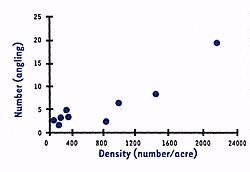
We designed a study to assess angler-catch information for largemouth bass in nine South Dakota ponds. The ponds ranged from less than 1 to almost 20 acres. All ponds were "sampled" by angling and also with our electrofishing boat. The boat has a generator that produces electricity, and a control unit that allows us to regulate how much electricity is used to temporarily stun fish. Electrofishing is most effective at night and is accepted and widely used by fishery biologists as a standard method for monitoring largemouth bass populations. Earlier in our study, we used what is known as a "mark and recapture" technique to actually estimate the number per acre for largemouth bass in each pond.
Not surprisingly, as numbers of largemouth bass increased, anglers also caught more largemouth bass per hour of angling (Figure 1). When bass density was low (50-250/acre), we caught only 2-5 bass per hour of angling. When bass density was moderate (900-1300/acre), we caught 6-8 bass per hour. When bass abundance was the highest (21(K)/acre), we caught an amazing 19 bass/hour.
Biologists and pondmeisters often want to know numbers and sizes of largemouth bass in a pond or lake. In our 9-pond study, we compared sizes of bass caught by angling to sizes we caught in our electrofishing samples (Figure 2). Once again, we were pleased with the results. When electrofishing indicated very few bass in the pond were greater than 12 inches, anglers caught a low percentage of bass over 12 inches. The four ponds that contained lots of smaller bass were classic examples of "stunted" (high density, slow growing) bass populations.
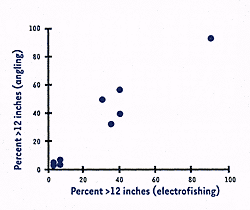
When electrofishing indicated moderate numbers of largemouth bass were 12 inches or longer, then anglers caught more medium sized bass. In the one pond with primarily larger bass, 90% of the bass caught by electrofishing were 12 inches or longer. At that pond, 94% of the bass caught by anglers were also 12 inches or more. [Which pond do you want to fish?] Results of this study showed that sampling of bass by angling can provide a pretty good estimate of the numbers and relative sizes of bass present in a pond.
The key to our success in this study was that ponds were either unfished or lightly fished. Several fisheries studies have shown largemouth bass exposed to high levels of fishing pressure do become more difficult to catch. Conditioning (or learning) of bass to avoid fishing lures throws a wrench into the concept that angling can be a good sampling method for largemouth bass. Next, let's explore some evidence that "experienced" bass become harder to catch.
Largemouth Bass Catchability
Researchers at the Illinois Natural History Survey completed an interesting study on this topic. First, let's look at their study design. They used three ponds, all about 0.2 acres in size. All ponds were stocked with the same number (420/acre) and the same sizes (9-13 inches) of largemouth bass. After bass were stocked, anxious samplers waited 2 weeks before fishing began. They varied amounts of fishing pressure at each pond (low, moderate, and high). All fishing was catch and release. At the end of the 3-month study, only two bass had died. One was lost in the low-pressure pond, and one in the high-pressure pond.
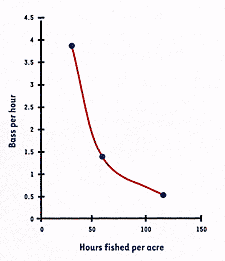
In the low-pressure pond, fishing amounted to 170 hours/acre, and anglers caught 3.0 bass per hour. In the moderate-pressure pond, anglers fished 340 hours/acre, and caught 1.2 bass per hour. In the high-pressure pond, angling was 680 hours/acre of water, and they only caught 0.4 bass per hour. The more experienced bass in the higher pressure ponds certainly learned, and were less likely to bite.
In the second part of the same study, researchers stocked each of three small ponds with 75 bass per acre. During the next 49 days, each pond received 23 sessions of catch and release fishing. Each session. Pond A was fished for 0.8 hour. Pond B for 1.6 hours, and Pond C for 3.3 hours. Figure 3 shows what happened. As fishing pressure increased, fish became harder to catch. Near the end of the study, no bass could be caught in Pond B or Pond C. The best bass fishing occurred and catch rates of bass persisted throughout the study period in Pond A. which had the shortest fishing sessions (0.8hr/ac). Bass seemed to learn more from the length of fishing sessions rather than the number of times the pond was fished. Again the more experienced the bass became, the harder they were to catch.
Potential Solutions?
So. what the heck can a pondowner do to combat this learned behavior of largemouth bass? We have a few suggestions.
The first "solution" for pondowners is to vary fishing technique. While this certainly does not solve the problem, it can help. New techniques with different types of lures are more likely to catch bass than methods previously used. Live bait often will help catch older and more elusive, experienced fish, but remember circle hooks or using larger hooks can greatly reduce hooking mortality by reducing the chance of a bass swallowing the offering.
A second "solution" is when you go, fish each outing for shorter periods of time. This is especially true if you have a smaller pond. The longer bass are exposed each time to fishing pressure the wiser they become. Spend some of your extra time fishing for other types of fish in the pond - maybe panfish or catfish. Spend more time managing fish by keeping track of their numbers, checking weights or measuring lengths and focus on removing selected fish to improve the balance of the overall fishery.
Our third "solution" borders on sacrilege! Perhaps we should consider eating some of the bass! While harvest may seem strange after years of kissing and releasing your bass, some turnover in the population will probably help angling catch rates. New or younger bass will not be as "experienced" or as cautious as old timers. A pondmeister with a typical Midwestern pond might have 50 pounds/acre of largemouth bass in a 3-acre pond, for a total of 150 pounds. What if 30 or 40 pounds of bass were filleted and eaten per year? That harvest would allow for turnover in the population because with harvest of some older and wiser bass there would be room for new, younger bass to grow into the adult population. Plus, that level of harvest would not affect predator-prey relations in a pond that contained 150 pounds of bass.
Always remember the concept of selective harvest. Which bass are the most experienced or the most abundant and thus best suited for harvest in your pond? Do you need to primarily harvest bass less than 14 inches long? Maybe only bass between 12 and 16 inches long should be harvested? The appropriate harvest will vary by 1) what is in your pond and 2) your management goal. If you are most interested in producing larger bass, then you probably should concentrate your harvest on the smaller bass (although the big ones may become tough to catch). If you are managing for a high-quality bluegill population by purposely crowding your largemouth bass, then perhaps you should have less total harvest of bass, and be sure that all 8-12 inch bass are protected. Harvest the occasional big and smart bass to keep bass catch rates at a higher level. Sacrilege indeed! Good fishing to all.
References
Isaak D.J., T.D. Hill, and D.W. Williv 1992. Comparison of size structure and catch rate for largemouth bass samples collected by electrofishing and angling. The Prairie Naturalist 24(2): 89-96.
Mankin, PC., D.P. Burkett. P.R. Beaty, W.F. Childers, and D.P. Philipp. 1984. Effects of population density and fishing pressure on hook-and-line vulnerability of largemouth bass. Transactions of the Illinois Academy of Science 77(3-4): 229-240.
Dr. David W. Willis is a professor in the Department of Wildlife and Fisheries Sciences, South Dakota State University in Brookings. Bill Cody is an expert aquatic microbiologist, based in Ohio. Both can be reached on the PB forum.
Reprinted with permission from Pond Boss Magazine

